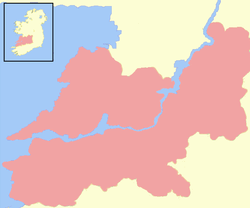Thomond
| Kingdom of Thomond | |||||
| |||||
 Thomond before the Norman invasion of Ireland | |||||
| Capital | Ennis | ||||
| Languages | Irish | ||||
| Government | Monarchy | ||||
| King | |||||
| - | 1118–1142 | Conchobar O'Brien | |||
| - | 1539–1543 | Murrough O'Brien | |||
| History | |||||
| - | Established | 1118 | |||
| - | Disestablished | 1543 | |||
| [1] | |||||
Thomond (Irish: Tuadhmhumhain, meaning North Munster, now spelled Tuamhain) is a region of Ireland associated with County Clare, County Limerick, north County Kerry and north County Tipperary; effectively most of north Munster. The name is used by a variety of establishments and organisations located in, or associated with the region. Thomond College of Education, Limerick was a teacher training college in Limerick City, until it was amalgamated with the University of Limerick. Thomond Park in Limerick is the rugby stadium used by the Munster Rugby team. Thomond Villas is the name given to the old army barracks at Clarecastle. The Thomond Bridge was for centuries the only bridge crossing the River Shannon in the ancient walled city of Limerick and still carries the road from the city of Limerick through a district known as Thomondgate.
Historically Thomond was one of the Kingdoms which existed in the island of Ireland before the Norman invasion. One of its notable kings was Brian Boru, ancestor of the O'Brien Clan of Dalcassians.
Creation
The entire Province of Munster was under the control of the O'Brien (Ua Briain) clan under the leadership of Toirrdelbach Ua Briain and his son Muirchertach from 1072-1114. Their capital was located in Limerick. In a bid to secure the High Kingship of Ireland for the clan, Muirchertach encouraged ecclesiastical reform in 1111 with the creation of territorial dioceses over the entire island. They had support for their bid from several foreign connections including Magnus Bareleg, the king of Norway and the Norman baron Arnulf of Montgomery in Wales who were both united to the clan through marriage in 1102.[2] Their claim to the High Kingship was countered by the O'Neill (Uí Néill) clan in Ulster under the leadership of Domnall MacLochlainn of Ailech. Though Muirchertach campaign hard in the north he was unable to obtain submission. When he fell ill in 1114 he was deposed by his brother Diarmait. Muirchertach did briefly regain power of the clan but after his death in 1119 his brother's sons took control of the clan.[2]
MacLochlainn's plans to restore the High Kingship to the north was thwarted by his ally Tairrdelbach Ua Conchobair of Connaght who formed an alliance with the O'Brien's. In 1118 Conchobair partitioned Munster between the sons of Diarmait and Tagh Mac Carthaig. The northern section of the province became the O'Brien Kingdom of Thomond and the southern became the Mac Cathaig Kingdom of Desmond.[2]
Territorial extent
County Clare was sometimes known as County Thomond in the period immediately after its creation from the District of Thomond.[3]
In 1841, an estimation of the extent of the kingdom was undertaken by John O'Donovan and Eugene Curry[4]
"The principality of Thomond, generally called the Country of the Dal-Cais, comprised the entire of the present Co. of Clare, the Parishes of Iniscaltra and Clonrush in the County of Galway, the entire of Ely O'Carroll, the Baronies of Ikerrin, Upper and Lower Ormond, Owney and Arra, and somewhat more than the western half of the Barony of Clanwilliam in the County of Tipperary; the Baronies of Owenybeg, Coonagh and Clanwilliam, and the eastern halves of the Baronies of Small County and Coshlea in the County of Limerick."[5]
Monarchs
Annalistic references
See Annals of Inisfallen (AI).
- AI927.3 Repose of Mael Corguis Ua Conaill, bishop of Tuad Mumu.
- AI953.3 Repose of Diarmait son of Aicher, bishop of Tuad Mumu.
- AI963.4 A slaughter of the Tuad Mumu on the Sinann, and they abandoned their vessels and were drowned.
- AI1018.2 Ciarmacán Ua Maíl Chaisil, bishop of Tuadmutnu, rested in Christ.
References
- ↑ "O'Brien (No. 1.) King of Thomond". LibraryIreland.com. Retrieved on 26 July 2009.
- ↑ 2.0 2.1 2.2 Byrne, F.J. Cosgrove, Art, ed. A New History of Ireland II:The trembling sod: Ireland in 1169. Royal Irish Academy. ISBN 9780199539703.
- ↑ Luminarium Encyclopedia: Biography of Sir Henry Sidney (1529–1586).
- ↑ John O'Donovan and Eugene Curry, "Ordnance Survey Letters", Part II. Letters and Extracts relative to Ancient Territories of Thomond, 1841
- ↑ Clare library, retrieved 21 March 2012.
Further reading
- Frost, James (1893). "Chapter 12. History of Thomond before it was formed into an English county: From the earliest times, to the death of De Clare, and expulsion of the English in 1318.". The history and topography of the county of Clare, from the earliest times to the beginning of the 18th century. Dublin: Printed for the author by Sealy, Bryers & Walker.
- Frost, James (1893). "Chapter 13. History of Thomond before it was formed into an English county: From the Death of De Clare in 1318 to the Formation of Thomond into an English County in 1580". The history and topography of the county of Clare, from the earliest times to the beginning of the 18th century. Dublin: Printed for the author by Sealy, Bryers & Walker.
External links
See also
- Munster
- Kingdom of Desmond
- Kingdom of Connacht
- Ailech
- Breifne
- Kingdom of Ulster
- Kingdom of Meath
| ||||||||||||||||||||||||||||||||||||||||||